From Israel to Midian, discover how 15 biblical nations shaped ancient history and divine tales, leaving you eager to explore their enduring legacies.
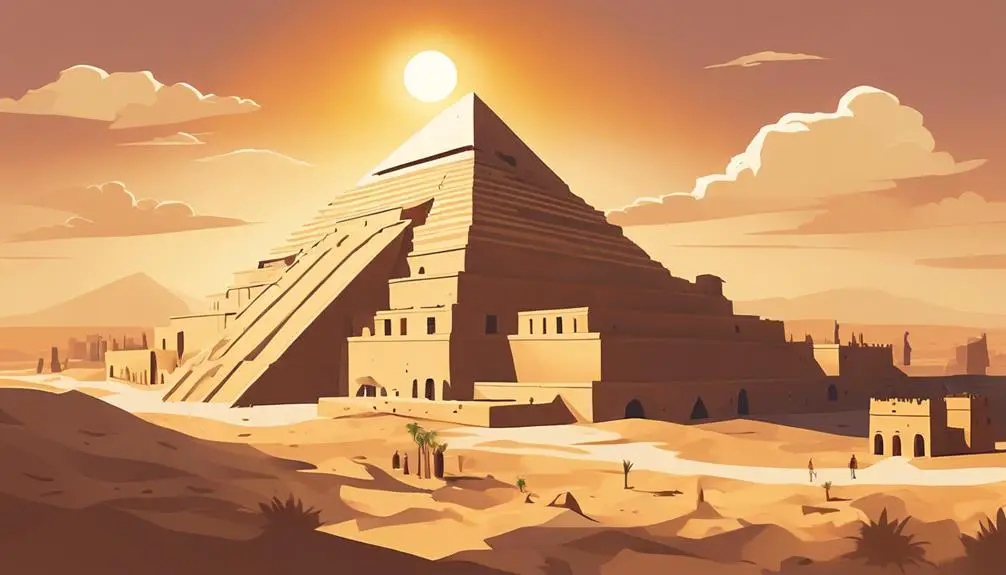
15 Nations in the Bible
Biblical narratives brim with stories of nations, each with its unique place and purpose in history. You've likely heard of Egypt's grandeur or Israel's pivotal role, but what about the lesser-known kingdoms like Midian or Aram?
These lands and their peoples played critical roles in shaping the biblical world and its stories. By exploring the tales of all 15 nations, you'll uncover a tapestry of divine interactions, human struggles, and ancient geopolitics.
The question remains, though, how did each nation influence the biblical narrative, and what can their stories teach us about the past that still resonates today?
Key Takeaways
- Biblical nations had unique cultures, from Egypt's pyramids to Babylon's astronomy.
- Trade and cultural exchanges were crucial, with nations like Edom and Philistia thriving through commerce.
- Political power varied, with empires like Assyria and Persia dominating at different times.
- Religious beliefs ranged from Israel's monotheism to Canaan's polytheism, shaping societal norms.
Egypt: The Pharaonic Power

Dominating the narrative of ancient Near Eastern history, Egypt's pharaonic power stands as a testament to its enduring influence and complex relationship with the nations described in the Bible. You delve into the intricacies of this civilization, focusing on two pivotal aspects: pyramid construction and the Nile civilization. These elements not only underscore Egypt's technological and architectural prowess but also highlight its socio-economic structures, which were deeply intertwined with its religious beliefs.
Pyramid construction, an engineering marvel of the ancient world, serves as a tangible representation of the pharaohs' quest for immortality and their divine status within the Nile civilization. As you explore this, you realize that these monumental structures weren't just tombs but a demonstration of the pharaohs' ability to mobilize and command vast resources and labor forces. This capability was crucial for maintaining their power and ensuring the stability of their reign over Egypt.
The Nile civilization, on the other hand, reveals the ingenious ways in which Egyptians harnessed the river's annual flooding to develop a highly productive agricultural system. This system supported not only the local population but also facilitated trade and interactions with neighboring regions. The Nile's significance extended beyond economics; it was central to Egyptian culture, religion, and identity. You grasp that understanding the role of the Nile is essential to comprehending the entirety of Egypt's pharaonic power and its influence on the broader Near Eastern region, including its complex interactions with the nations mentioned in the Bible.
Israel: God's Chosen People
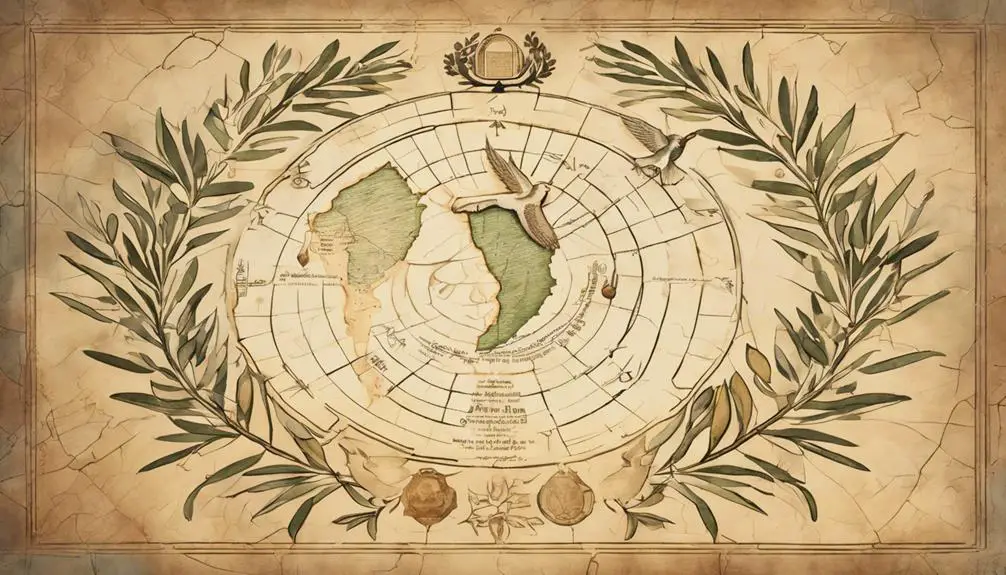
In the tapestry of Biblical narratives, Israel emerges as a central figure, chosen by God to fulfill a unique role among the nations. This selection wasn't just a title; it carried profound covenant significance and established Israel in prophetic roles that would echo through history. Understanding why Israel is considered God's chosen people requires delving into these elements deeply.
- Covenant Significance: The covenant between God and Israel, initiated with Abraham, was both a promise and a set of obligations. It wasn't merely a contract; it was a deep, ongoing relationship with God that set Israel apart for a holy purpose.
- Prophetic Roles: Israel was tasked with being a 'light to the nations.' Prophets arose from among them, not only to guide Israel but to project God's messages to the world.
- Land and Identity: The promise of land wasn't just about territory; it was a sign of God's faithfulness and a key part of Israel's identity.
- Law and Ethical Monotheism: The Law given to Moses on Sinai shaped Israel's ethical, social, and religious life, introducing a monotheistic faith centered around justice and compassion.
- Exile and Restoration: Periods of exile refined Israel's identity and faith, underscoring their reliance on God and the hope of restoration, themes central to their prophetic messages.
Israel's role as God's chosen people is layered, marked by covenant, prophecy, and a profound relationship with the divine. This status wasn't about privilege but purpose, calling them to be a model of faith and obedience to God's will.
Babylon: Empire of Splendor
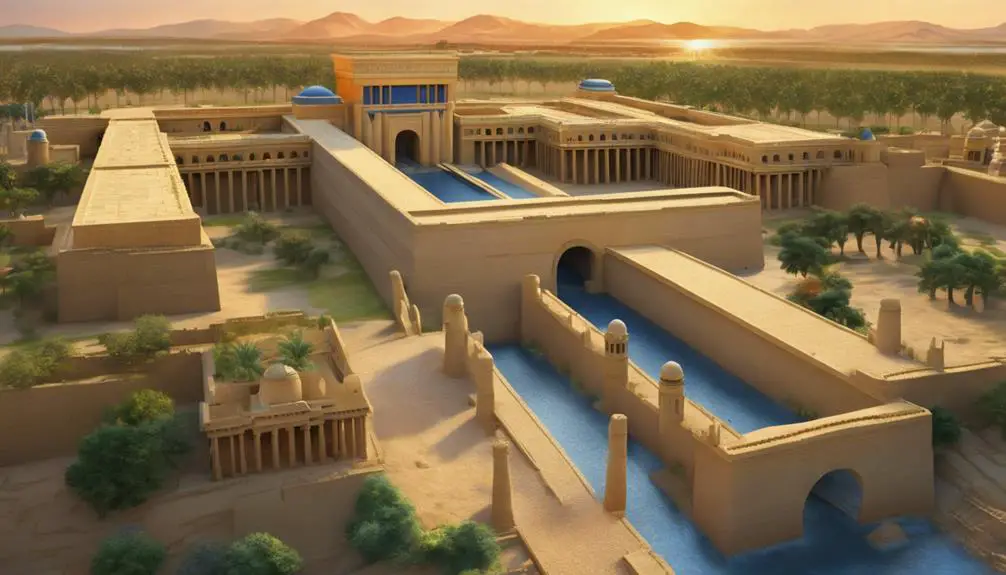
While Israel was distinguished by its covenant and prophetic significance, the ancient empire of Babylon emerged as a remarkable testament to human achievement and cultural splendor. You'd find that Babylon's contributions to civilization were as varied as they were impactful, with Babylonian astronomy serving as a prime example of their advanced understanding of the cosmos. They meticulously charted the movements of the stars and planets, laying the groundwork for future astronomical discoveries. Their sophisticated lunar calendar was pivotal in the development of timekeeping and influenced numerous cultures that came after them.
Another testament to Babylon's grandeur is the legendary Hanging Gardens, one of the Seven Wonders of the Ancient World. Although debates persist about their existence, they symbolize Babylon's architectural and engineering prowess. Supposedly built by King Nebuchadnezzar II for his homesick wife, these gardens showcased an advanced irrigation system that kept them flourishing in the arid Mesopotamian climate. This feat wasn't just a display of love but a demonstration of Babylon's technological advancements and their mastery over their environment.
Babylon wasn't just an empire of military might; it was a beacon of culture, innovation, and artistry. Its contributions to astronomy and monumental architecture left a lasting legacy that not only influenced subsequent empires but also continues to fascinate modern scholars and enthusiasts. As you delve deeper into Babylon's history, you uncover a civilization that, in its time, stood as a pinnacle of human ingenuity and cultural achievement.
Assyria: The Iron Age Giant
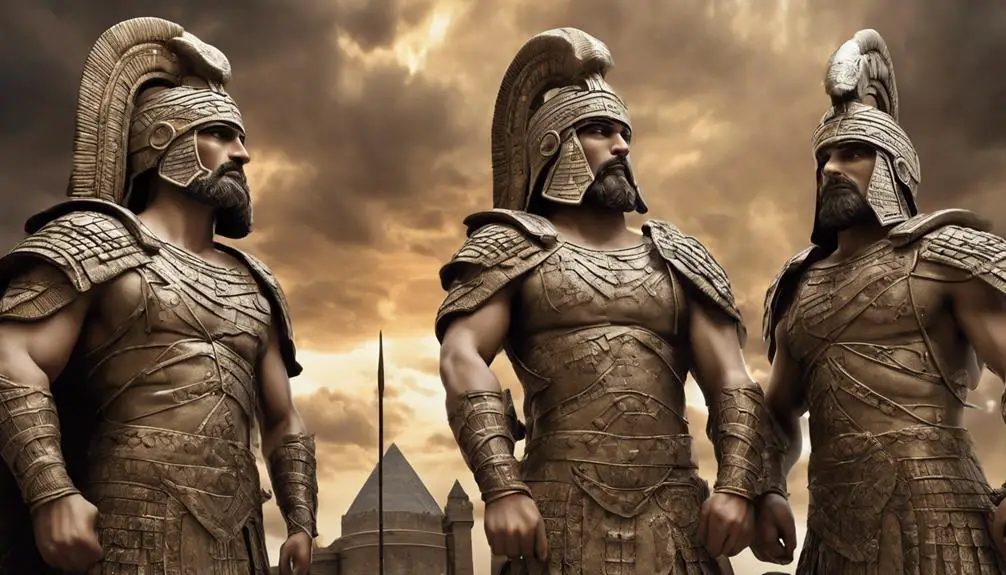
Assyria, a formidable Iron Age empire, carved out its legacy through military innovation and stringent administrative strategies, setting the stage for its historical dominance. This civilization, known for its aggressive expansion and sophisticated societal structures, remains a subject of fascination among historians and scholars. Your understanding of Assyria's impact on the ancient Near East deepens as we delve into the core aspects that defined its era.
- Military Tactics: Assyria's military prowess was unmatched, thanks to its adoption of iron weaponry and the introduction of siege techniques that overwhelmed even the most fortified cities. The empire's success in battles was largely due to its organized and ruthless army, which utilized chariots and cavalry to devastating effect.
- Assyrian Architecture: Reflective of their might, Assyrian kings built grandiose palaces and temples, showcasing elaborate reliefs depicting their conquests and deities. The use of thick mud bricks and vast courtyards in their constructions emphasized both durability and a display of power.
- Administrative Efficiency: Assyria's administrative system was highly advanced for its time, with a centralized government that effectively controlled its vast territories through a network of governors and local rulers, ensuring loyalty and efficient tax collection.
- Legal System: The empire developed a comprehensive set of laws that governed everything from trade to personal conduct, highlighting their emphasis on order and justice within their society.
- Cultural Contributions: Assyrian culture enriched the ancient world through its advancements in art, literature, and science, leaving a legacy that influenced subsequent civilizations.
Through these elements, Assyria's role as an Iron Age giant comes into sharper focus, revealing a civilization that was both feared and admired for its innovations and governance.
Persia: Rise of the Achaemenids
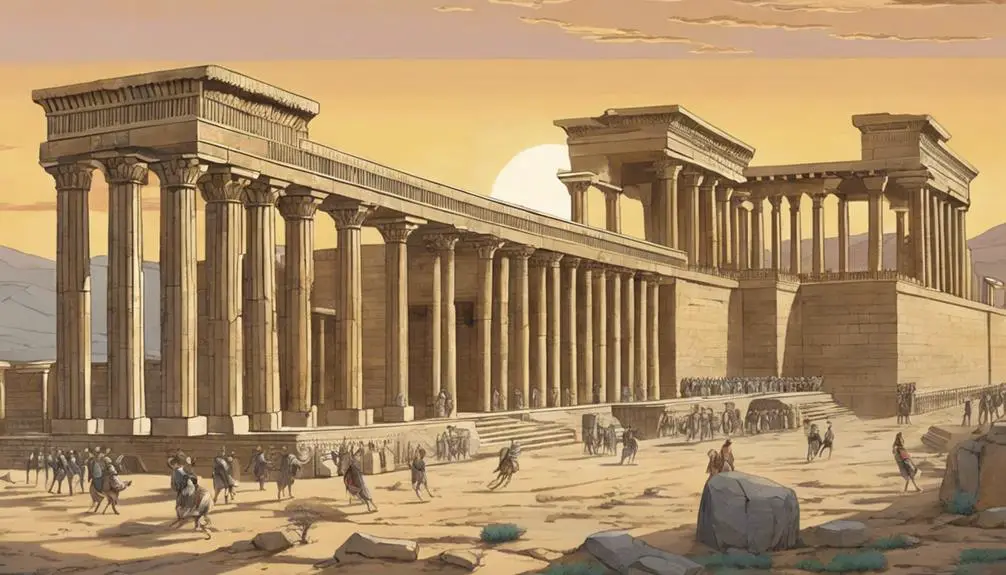
Shifting focus to another ancient powerhouse, we now explore the rise of the Achaemenid Empire, renowned for its innovative governance and expansive reach. The foundation of this empire under Cyrus the Great marked a pivotal shift in the ancient Near East's political landscape. Cyrus's approach to leadership was groundbreaking, especially his policy of tolerance towards the cultures and religions within his domain. This approach not only facilitated the peaceful integration of conquered peoples but also allowed for a degree of autonomy under the imperial structure.
Cyrus's tolerance wasn't merely a political strategy; it was partly influenced by the prevailing religious beliefs of the time, notably Zoroastrianism. Zoroastrianism's impact on the empire was profound, fostering a sense of justice and moral duty that permeated Achaemenid governance. The religion's emphasis on truth and righteousness resonated with Cyrus's own policies, which sought to maintain order and prosperity within the empire's vast territories.
The Achaemenid Empire's administrative system was another testament to their innovative spirit. By dividing their empire into satrapies, or provinces, each governed by a satrap, they managed to maintain control over a vast and diverse territory. This system ensured efficient governance and facilitated communication across the empire's extensive reach, from the Indus Valley to the Aegean Sea.
Moab: Neighbors and Adversaries
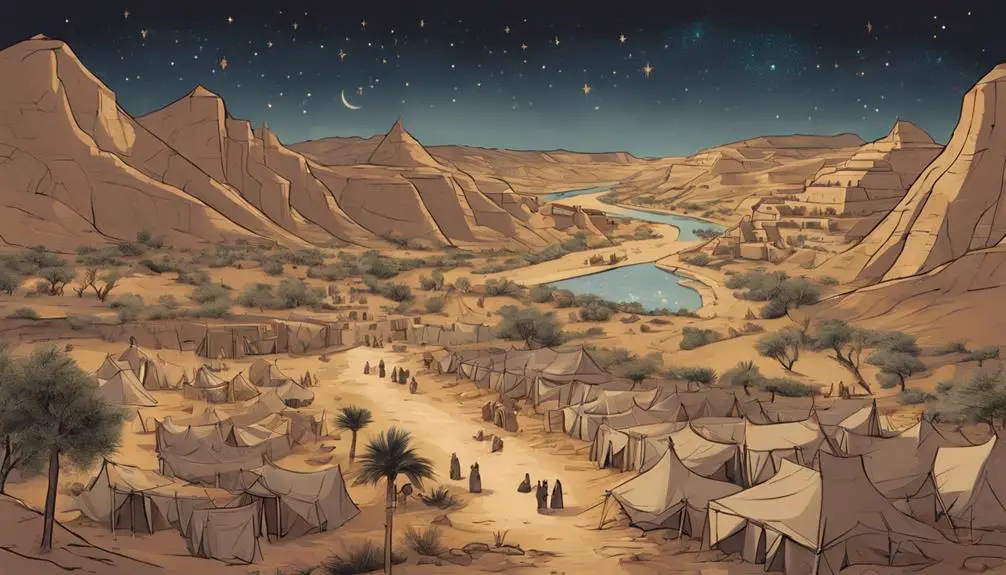
Historically, Moab often found itself entangled in a complex relationship with neighboring Israel, oscillating between periods of peace and conflict. This dynamic interplay wasn't only a matter of political and military engagements but also deeply influenced by cultural and religious exchanges. When you delve into the Moabite culture, several facets stand out, particularly their religious practices, which were both similar to and distinct from those of Israel.
- Religious Practices: Moabites worshipped a pantheon of gods, with Chemosh being the most significant. This deity's role in Moabite society mirrors the central position of Yahweh in Israelite worship, yet the specific practices and beliefs surrounding Chemosh highlight the unique aspects of Moabite spirituality.
- Cultural Exchanges: Over time, Moab and Israel influenced each other's cultures, including language, architecture, and societal norms. This exchange was facilitated by periods of peace and intermarriage.
- Political Alliances and Conflicts: The relationship between Moab and Israel was marked by fluctuating alliances and hostilities. These shifts often reflected broader regional power dynamics, including threats from other neighboring nations.
- Economic Interdependence: Despite their conflicts, Moab and Israel engaged in trade, which was vital for both economies. This economic interdependence sometimes served as a stabilizing factor in their relations.
- Literary References: The Bible and Moabite inscriptions, such as the Mesha Stele, provide insights into the interactions between these two nations, offering a glimpse into their shared history and divergent paths.
Understanding the Moabite culture and religious practices sheds light on the complex web of interactions that defined the Moab-Israel relationship, illustrating the fine line between cooperation and conflict among ancient Near Eastern neighbors.
Edom: Descendants of Esau
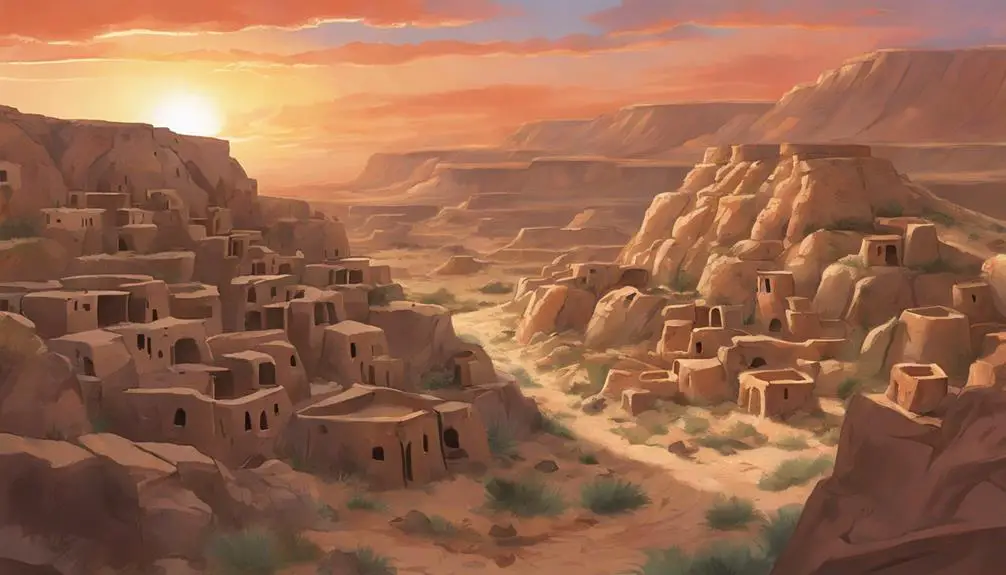
Tracing the lineage of the Edomites back to Esau, Jacob's brother, reveals a foundational aspect of their identity and its implications for their historical interactions with Israel. Esau's legacy, deeply intertwined with the birthright story, where he trades his inheritance for a meal, sets the stage for the complex relationship between the Edomites and Israelites. This narrative not only shapes the theological perspectives of these nations but also highlights the enduring impact of familial ties and conflicts in shaping their histories.
Delving into Edomite culture, you uncover a society that was both influenced by and distinct from its Israelite neighbors. The Edomites, descendants of Esau, developed a culture characterized by its unique religious practices, social structures, and economic activities. Their strategic location along trade routes not only facilitated commercial prosperity but also exposed them to a myriad of cultural influences, which they absorbed and adapted into their own societal fabric.
Esau's legacy is evident in the resilience and identity of the Edomite people. Despite the adversarial aspects of their relationship with Israel, the Edomites managed to carve out a significant historical and cultural niche in the ancient Near East. Their story, encapsulated in the biblical narrative, offers valuable insights into the complexities of kinship, rivalry, and coexistence in the ancient world.
Analyzing Edomite culture and its roots in Esau's lineage provides a nuanced understanding of their place in biblical history, emphasizing the intricate interplay between familial legacy and cultural development. This exploration affords a deeper appreciation of the diverse nations that populate the biblical narrative, each contributing to the rich tapestry of human history documented in these ancient texts.
Philistia: The Coastal Rivals
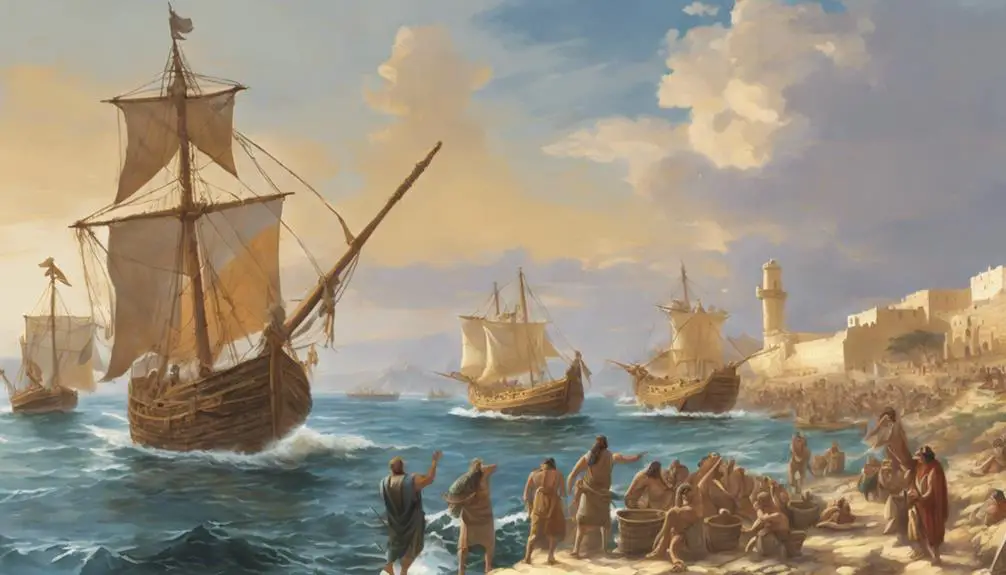
While the Edomites developed their identity through familial legacies and cultural adaptability, the Philistines, as coastal rivals, forged a distinct path that set them apart in the biblical narrative. Originating from the mysterious Sea Peoples, they settled along the southern coast of Canaan, bringing with them a culture that was both unique and influential.
Philistine culture was marked by its sophistication and distinctiveness, setting a sharp contrast to their neighboring tribes. They're often depicted as the formidable adversaries of the Israelites, but their contribution to the historical and cultural tapestry of the region is undeniable. Here are key aspects that define the Philistines:
- Military Prowess: Known for their formidable chariots and well-organized armies, they were a constant threat to the Israelite territories.
- Architectural Innovations: Their cities were fortified with impressive structures, reflecting a sophisticated understanding of urban planning and defense.
- Art and Craftsmanship: Philistine artifacts display a high level of skill, particularly in pottery, which showcases a blend of local and Aegean influences.
- Maritime Trade: Utilizing their coastal position, they engaged in extensive trade networks, which contributed to their wealth and the diversity of their culture.
- Cultural and Religious Practices: Their religious beliefs and practices, while not fully understood, show significant differences from their neighbors, hinting at a rich spiritual tradition.
The Philistines' legacy is a testament to their role as a major player in the biblical era, offering a glimpse into the vibrant mosaic of ancient Near Eastern societies. Their history invites us to look beyond the conflicts and appreciate the complexity of their civilization.
Ammon: Kin of Israel
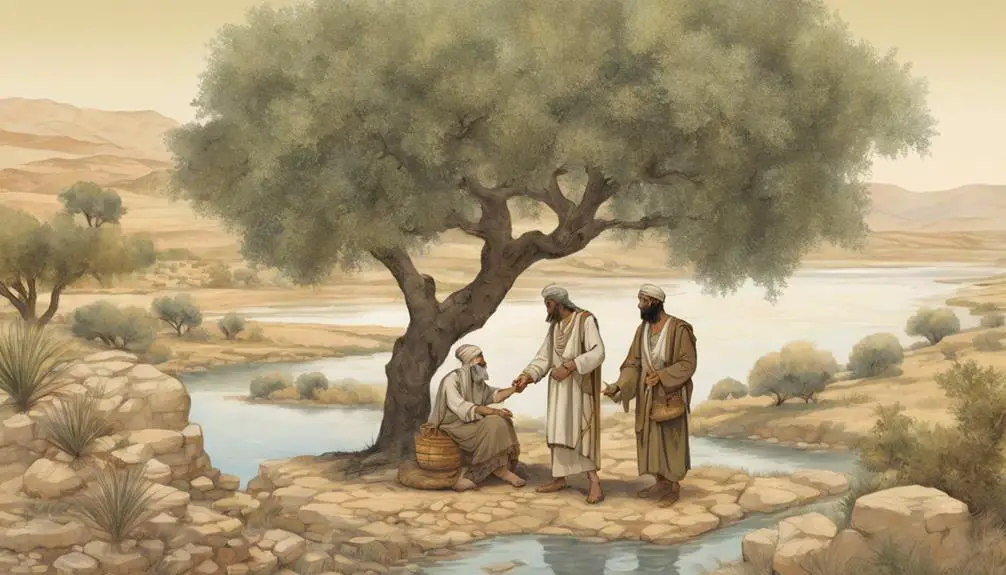
Delving into the history of Ammon reveals a complex relationship with Israel, marked by familial ties and intermittent conflict. You'll find that the Ammonites, descendants of Lot, Abraham's nephew, shared a kinship with the Israelites, yet their interactions often swung between peaceful coexistence and outright warfare. This dynamic is pivotal in understanding the geopolitical and cultural exchanges that shaped their histories.
The Ammonite religion, distinct yet influenced by surrounding cultures, played a significant role in this relationship. Their worship of the god Milcom sometimes clashed with Israelite beliefs, leading to religious and political tensions. Despite these differences, there were periods of assimilation and mutual cultural exchange that suggest a complicated layer of interaction beyond mere conflict.
Trade routes further complicate the story of Ammon and Israel. These routes were lifelines for both nations, facilitating the exchange of goods, ideas, and technologies. The Ammonites controlled significant portions of these trade networks, which often made them a target for Israelite expansion but also provided opportunities for cooperation and economic interdependence. The control and security of these routes could lead to alliances or wars, influencing the power dynamics between Ammon and Israel at various times.
Analyzing the Ammon-Israel relationship reveals a tapestry of kinship, religious divergence, and economic interdependence. The fluctuations in their interactions highlight the complexities of ancient Near Eastern politics, where familial ties could both mitigate and exacerbate conflict, and where control of trade routes was a critical factor in the survival and prosperity of a nation.
Canaan: The Promised Land

Canaan, often referred to as the Promised Land in biblical texts, occupies a central role in the narratives of ancient Israel, serving as both a geographical goal and a theological symbol. This region, storied and complex, isn't just a backdrop for biblical events; it's a dynamic character in its own right, shaped by its inhabitants and their practices.
Analyzing Canaan requires an understanding of Canaanite culture and agricultural practices, which were integral to the region's identity:
- Rich Canaanite Culture: The Canaanites weren't a monolithic group but a collection of city-states, each with its distinct gods, rituals, and social structures. Their polytheistic beliefs and practices, depicted in various archaeological findings, offer a glimpse into a society deeply connected to its deities and natural surroundings.
- Agricultural Practices: Canaan's fertility was legendary, making it the 'land flowing with milk and honey'. The Canaanites were skilled farmers, utilizing advanced agricultural practices to cultivate grains, fruits, and vegetables. Their irrigation techniques and crop rotation methods maximized the yield from the land.
- Urban Centers: Canaan was dotted with fortified cities, each acting as a hub for trade, worship, and governance. These cities were centers of Canaanite civilization, showcasing advanced architecture and urban planning.
- Art and Craftsmanship: Canaanite artisans were renowned for their craftsmanship, especially in pottery, metalwork, and textile production. These goods weren't only used locally but also traded with neighboring regions.
- Cultural Exchange: Positioned at the crossroads of Africa and Asia, Canaan was a melting pot of cultures, ideas, and innovations. This exchange enriched Canaanite society, making it one of the most vibrant regions of the ancient Near East.
Canaan's story is one of complexity and contrast, where agricultural prowess and cultural richness defined a land considered promised yet perennially contested.
Hittites: The Anatolian Force
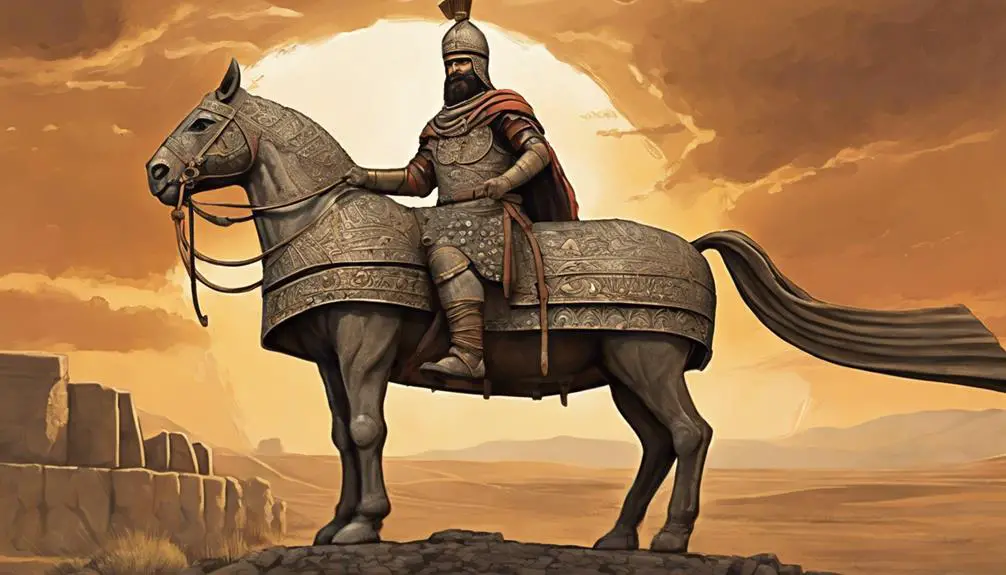
Shifting our focus northward, we encounter the Hittites, an Anatolian powerhouse whose influence and interactions with the Canaanites reveal a complex web of geopolitical dynamics. The Hittites, known for their mastery in iron smelting, were a force to be reckoned with. Their advancements in technology not only gave them an edge in warfare but also in economic trade and diplomacy.
Hittite mythology, rich and multifaceted, played a central role in their society. It intertwined with their legal and political systems, influencing decisions and shaping their worldview. The gods they worshipped and the myths they told were not mere stories but a reflection of their understanding of the world and their place within it.
The table below offers a glance at the Hittites' contributions and interactions within the ancient Near Eastern landscape:
Aspect |
Description |
|---|---|
Geopolitical Impact |
Established vassal states, influencing politics and trade in the region. |
Technological Advance |
Pioneered in iron smelting, revolutionizing warfare and agricultural tools. |
Cultural Influence |
Hittite mythology enriched the tapestry of ancient Near Eastern beliefs. |
Diplomatic Engagements |
Crafted treaties and alliances, notably with Egypt, stabilizing the region. |
Analyzing the Hittites' legacy, it's clear their impact was profound. Their technological prowess, coupled with a sophisticated understanding of diplomacy and a rich cultural heritage, positioned them as a dominant force in the ancient Near East. Their interactions with neighboring Canaanites, among others, underscore the interconnected nature of these ancient civilizations, weaving a narrative of competition, cooperation, and cultural exchange that shaped the course of history.
Midian: Wilderness Dwellers
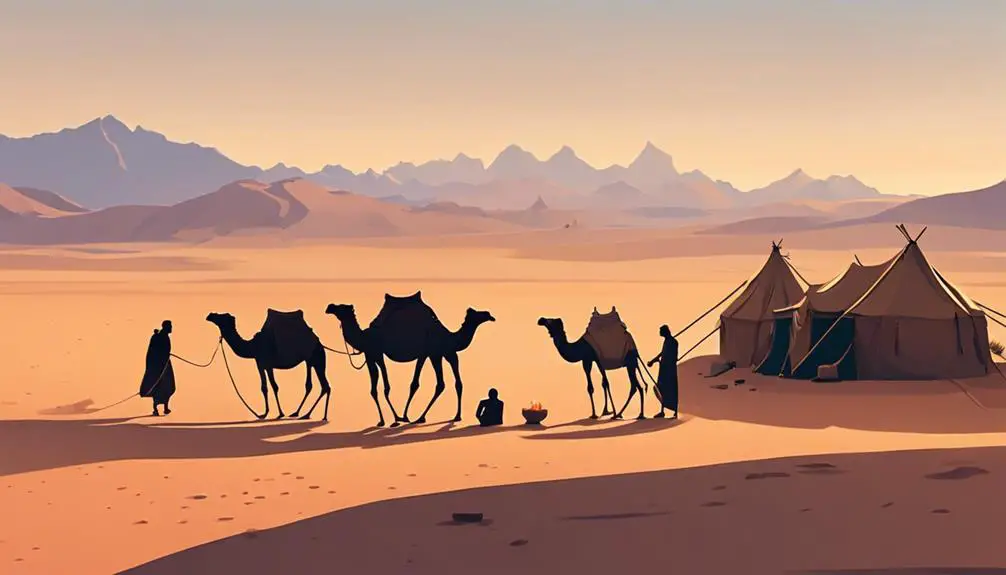
Venturing into the deserts, you'll find the Midianites, a group whose lifestyle and culture were shaped by the harsh wilderness they called home. Living in a region that demands resilience, the Midianites developed a society that was both unique and integral to the history of the ancient Near East. Their strategic position along crucial trade routes allowed them not only to survive but to thrive in an environment that was unforgiving to the unprepared.
The Midianites' culture and economy were deeply intertwined with these trade routes, facilitating exchanges that went beyond mere goods; they were conduits for cultural practices, ideas, and technologies that shaped the region. Their nomadic lifestyle, adapted to the challenges of desert life, was reflected in their social structures, religious practices, and interactions with neighboring nations.
- Trade Routes: Essential for their economic survival, these paths facilitated exchanges of goods and culture.
- Cultural Practices: Influenced by their environment and exchanges along trade routes, their traditions were distinct yet interconnected with the wider region.
- Nomadic Lifestyle: Adapted to the rigors of desert life, their societal structure was mobile and flexible.
- Social Structures: Their community was organized in a way that maximized resource use and cohesion among members.
- Religious Practices: Their beliefs were reflective of their close relationship with the natural world and its cycles.
Analyzing the Midianites offers insight into how civilizations adapt to their environments and how those adaptations influence broader regional dynamics. Their story is a testament to the resilience of human societies in the face of environmental challenges and the complex interplay between geography, economy, and culture.
Aram: The Syrian Kingdoms
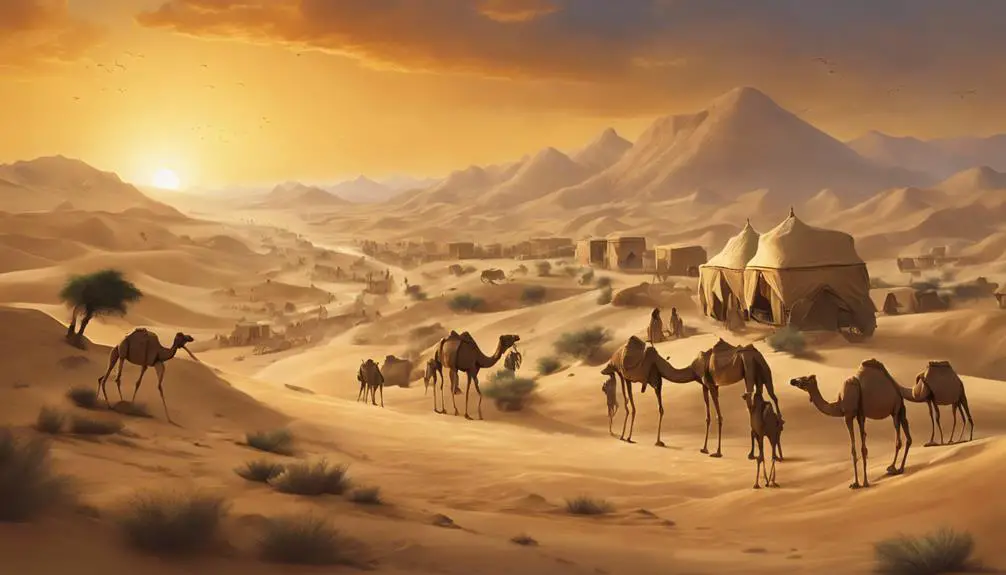
The Syrian Kingdoms of Aram emerged as pivotal centers of trade, culture, and political power in the ancient Near East, profoundly influencing the geopolitical landscape of the region. Situated at the crossroads of multiple civilizations, these Aramean states leveraged their strategic locations to facilitate and control significant portions of the regional trade networks. You'll find that their economy thrived on this Aramean trade, not only enriching the local kingdoms but also fostering cultural exchanges and innovations that rippled through the ancient world.
The most notable among these kingdoms was the one with Damascus as its capital. This city, often mentioned in biblical and historical texts, served as both a political and economic hub. Its influence extended far beyond its immediate borders, affecting the politics, trade, and military strategies of neighboring nations. Damascus's prominence in Aramean and regional affairs underscored the importance of urban centers in the ancient Near East, acting as nodes in the vast networks of trade and political alliances.
Moreover, the Arameans weren't isolated in their pursuits. Their trade networks connected them with the wider Mediterranean world, introducing Aramean goods and culture to distant lands. This exchange wasn't one-way; it also allowed foreign influences to permeate Aram, illustrating the dynamic interchange between the Arameans and their neighbors.
As you delve deeper into the history of the Aramean kingdoms, you'll appreciate their role in shaping the cultural and political landscapes of the ancient Near East. Their legacy, particularly that of Damascus, highlights the complex interplay of local and regional dynamics that characterized this period.
Greece: Hellenic Influences
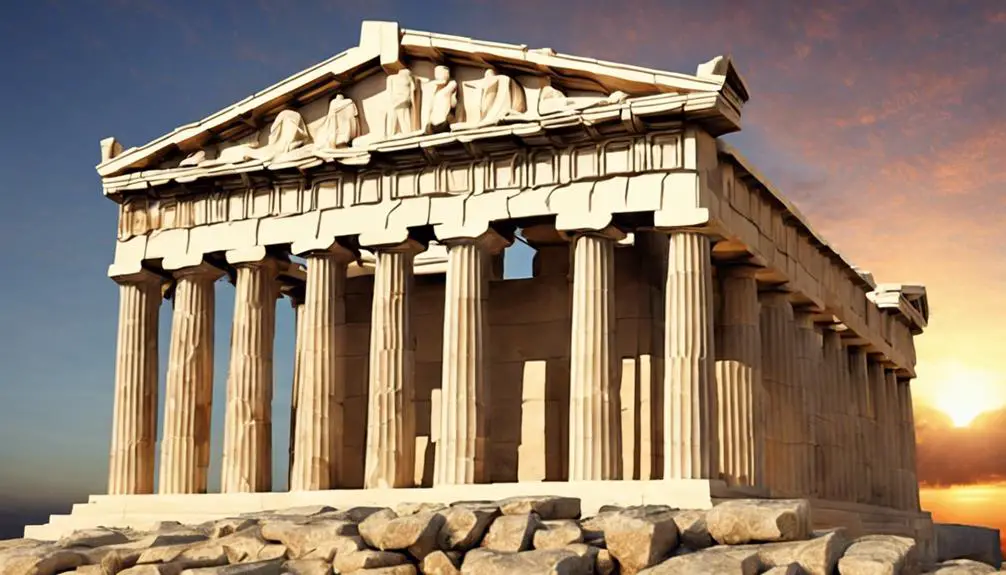
Exploring Hellenic influences reveals how Greek culture significantly shaped the religious, artistic, and philosophical landscapes of the ancient Mediterranean world. The Greeks didn't just give us myths and sculptures; their impact is deeply embedded in various aspects of contemporary life. Let's delve into the specifics:
- Olympic Origins: The Olympics, a festival dedicated to Zeus, showcased not only physical prowess but also cultural achievements. This tradition of celebrating sports and art continues globally, underscoring Greece's lasting legacy in fostering international camaraderie through competition.
- Philosophical Contributions: Greece is the cradle of Western philosophy. Figures like Socrates, Plato, and Aristotle challenged existing notions of knowledge, ethics, and governance. Their inquiries laid the groundwork for critical thinking and scientific inquiry that influence modern educational systems.
- Democratic Ideals: The concept of democracy in Athens, where citizens had a say in governance, has been a model for numerous nations striving for freedom and equality. Although not without its flaws, the Athenian democracy highlighted the importance of public discourse in society.
- Artistic Innovations: From the perfection of the Doric and Ionic columns to the development of realistic sculpture and the drama genre in literature, Greek art set standards that artists admire and emulate millennia later.
- Mythological Influence: Greek mythology has permeated various cultures, influencing literature, art, and psychology. The tales of gods, heroes, and mythical creatures not only served religious purposes but also provided moral lessons and entertainment.
These aspects collectively illustrate how Hellenic influences extensively molded the foundations of Western civilization, leaving imprints that are both profound and enduring.
Rome: The Imperial Power
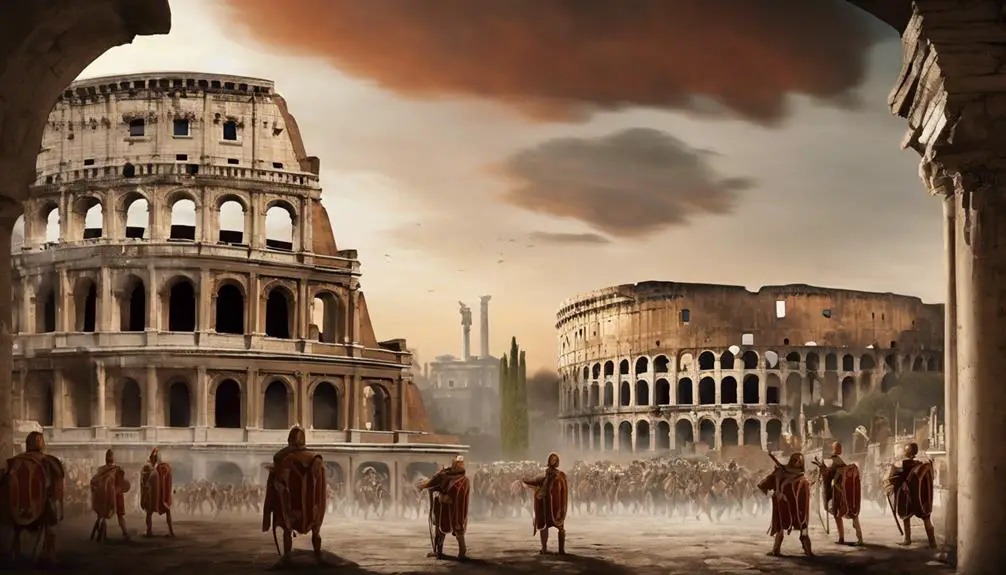
As we examine the vast influence of Hellenic culture, it's crucial to also recognize Rome's role as a formidable imperial power and its impact on the ancient world and beyond. It's impossible to discuss Rome without highlighting Caesar's reforms, which were foundational in transitioning the Republic into what would become the Empire. These reforms touched every aspect of Roman life, from the calendar to the expansion of the Senate, and they played a critical role in centralizing power and stabilizing the economy. Caesar's vision laid the groundwork for an empire that would last centuries, influencing legal systems, governance, and military strategies that are still studied today.
You can't ignore the cultural aspects of Roman power, and amongst these, the Gladiatorial games stand out. These games were more than mere entertainment; they were a tool for social control, a way to demonstrate the might of the empire, and to distract the populace from economic or political issues. The games were a complex symbol of Rome's power, showcasing not only the physical prowess of the gladiators but also the emperor's ability to provide for and control his subjects.
Rome's influence extends far beyond its military conquests. It's seen in the roads that connected the empire, facilitating trade and cultural exchange, and in the legal principles that form the basis of many modern laws. Understanding Rome's role as an imperial power helps us appreciate the intricate tapestry of influences that shaped the ancient world and continue to impact our lives today.
Frequently Asked Questions
How Did Trade and Commerce Among the Biblical Nations Influence Their Relationships and Cultural Exchanges?
In your exploration of how trade and commerce shaped relationships and cultural exchanges, it's fascinating to see the impact on religious rituals and architectural influences. Through trading, you'd find that shared beliefs and design elements became more common across different societies.
This blend not only enriched cultural diversity but also fostered a deeper understanding and appreciation among these groups. It's a testament to how economic interactions can transcend mere transactions and weave into the cultural fabric.
In What Ways Did the Environmental and Geographical Factors Shape the Political and Social Structures of the Nations Mentioned in the Bible?
You're exploring how environmental and geographical factors impacted political and social structures. Climate adaptation and agricultural practices were pivotal.
These environmental conditions dictated where and how communities settled, cultivated land, and interacted with neighboring groups. Efficient adaptation led to surplus production, influencing social hierarchies and political power dynamics.
Essentially, the success in harnessing the natural environment shaped societies, determining their stability, expansion, and influence over others.
How Did the Representation and Perception of These Ancient Nations Change in Biblical Narratives Over Time, and What Factors Contributed to These Shifts?
As you delve into the representation and perception shifts of ancient entities over time, it's crucial to note how cultural shifts and narrative evolution played pivotal roles.
These changes weren't random; they were deeply influenced by evolving societal norms, conquests, and interactions with other cultures.
This complex interplay not only altered how these entities were depicted but also how they were remembered, highlighting the dynamic nature of historical and cultural narratives.
What Role Did Women Play in the Socio-Political and Religious Spheres of These Ancient Nations as Depicted in the Bible?
You're diving into the heart of history, unraveling the roles women played in shaping societies. Analyzing these ancient settings, female prophets and maternal lineages emerge as pivotal. Their influence wasn't just confined to the home; they shaped socio-political and religious landscapes, challenging and changing perceptions.
These women weren't mere figures in the background; they were central, their roles deeply intertwined with the fabric of their societies, guiding, and influencing the course of history.
Can We Find Evidence of Diplomatic Interactions or Treaties Among the Biblical Nations Outside of Warfare and Conflict Narratives?
Yes, you can find evidence of diplomatic interactions or treaties beyond warfare and conflict narratives.
Marriage alliances were a common strategy to cement political relationships between different groups. Additionally, religious diplomacy played a significant role, as shared beliefs or rituals could bridge communities, leading to peaceful coexistence or alliances.
These strategies were crucial for maintaining stability and fostering cooperation, showing a nuanced approach to diplomacy in ancient times.
Conclusion
So, you've just time-traveled through the annals of history, mingling with the mightiest of empires and the humblest of dwellers, all from the comfort of your current century.
From Egypt's monumental ego, sorry, pyramids, to Rome's obsession with grandeur (compensation, much?), you've seen it all. These nations, with their quirks and conquests, prove history isn't just about dates and dusty artifacts; it's an endless soap opera.
Remember, every empire has its day, until it doesn't. Keep watching, the past always repeats itself.

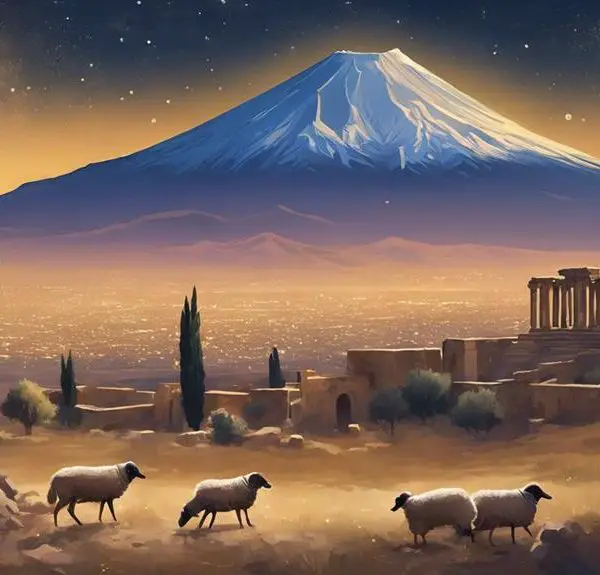
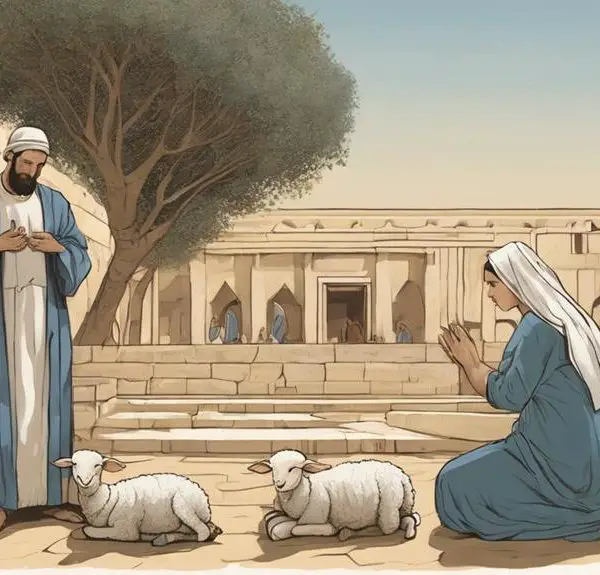
Sign up